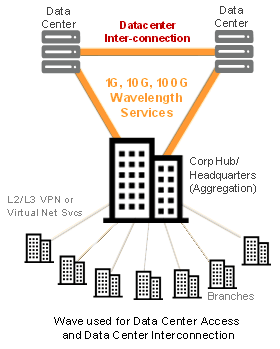Resumen
The Wavelength Services Solution provides point to point Dense Wavelength Division Multiplexed (DWDM) transport of 1 Gigabit (G), 10G or 100G services via Ethernet, Optical Transport Network (OTN), Synchronous Optical Network/ Synchronous Digital Hierarchy (SONET/SDH) or Storage Area Networking (SAN) protocol handoffs. Verizon’s state of the art Ultra Long Haul network is used without packet switching or packet aggregation to minimize latency and lower costs for point to point circuits. Circuits are layer 1 physical circuits that are Optical Transport Network (OTN) multiplexed, standards-based multiplexing and may be OTN switched (akin to a semi-permanent cross-connect). The customer’s circuit is never manipulated at the packet level other than to map them into OTN frames for transport.
Wave Product Portfolio:
- Wavelength Services Solution - The standard Wave product is available in the Domestic US and in limited geography in EMEA and APAC. No-sign SOF (Service Order Forms) means contracting is simple and fast, with online terms and conditions. Point to point circuit options include 1GbE, 10 GbE, 100GbE, OC-192, STM-64, OTU2. The SLA (Service Level Agreement) features 99.5% network availability for un-protected service and up to 99.99% for protected service. It also carries a 4 hour Mean Time to Repair (MTTR) metric. All Wave products use our state of the art ROADM-based (Reconfigurable Optical Add Drop Multiplexer) DWDM (Dense Wavelength Division Multiplexer) networks. Access protection is an option. Our OTN mesh offers unique mesh restoration options at 10G that reduces the cost of protection. A Mandatory Route Option and Route Diverse Mated Pairs are also possible for long haul service. A RTD (Round Trip Delay) SLA is also an option for long haul service. This forward-looking platform will roll out 400GbE service in the coming years. Available in on-net or off-net locations or when the customer is co-located at one of our data centers or Points of Presence (POP).
- Linear Global Data Link (LGDL) - The legacy international wave product at 10Gb/s (via 10GbE, OTU2 or STM-64) or 100GbE or OTU4 offers the strong SLA metrics feature the same network availability as the standard product with tiered MTTR. LGDL is the lone product sold when circuits cross country borders.
- Metro Private Line (MPL) - The legacy domestic US metro Wave product supports point to point speeds at 2.5G (SONET), 10GbE, OTU2, 40GbE, 100GbE or OTU4, Fiber Channel at 1/2/4/10G. It also supports hub and spoke networking into 10G hub facilities that can fan out OC-3/12/48 or 1GbE or the Fiber Channel interfaces. Offnet is supported on one end. Customer co-locations are also supported. Circuits with Automatic Protection Switching are an option.
- Metro Private Line – Dedicated Multiplexing System (MPL-DMS) – A Private Wave ring product, it allows the customer to order private ROADM nodes at specified locations in a ring topology. These ROADMs are installed, provisioned and maintained by Verizon but the ROADM and its fibers are dedicated to one customer. MPL circuits are then ordered between them (called Appearances) as needed and support protected or un-protected appearances.
- US Private Line (USPL) – The legacy domestic US long haul wave service with point to point service at 10G (via 10GbE, OTU2 or OC-192), 40GbE, 100GbE, OTU4. USPL offers the same metrics for availability and MTTR as the standard product with like pricing. Route Diversity and Mandatory Route options are available, as is custom routing.
- Optical Wave Service (OWS) – The Verizon Incumbent Local Exchange Carrier (ILEC) intra-LATA Wave service within our ILEC region. Supports point to point speeds of 2.5G, 10G (10GbE or SONET OC-192) or 100GbE. Module Diversity and Route Diversity are available where the network supports them. Protection is also available. The SLA metrics match that of the standard product.
- Integrated Optical Wave Service (IOS) – The Verizon ILEC private ring product, IOS allows customers to order dedicated ROADMs at their specified locations in a ring topology and order appearances (circuits) between them. Un-Protected and Protected appearances are available and access from other products is also available. The fibers are also dedicated to the customer. The ROADMs and fiber are installed, provisioned and maintained by Verizon.
Here is a graphic depicting a typical Wavelength Services use case:

Verizon can provide Wave service to off-network (off-net) locations, shared data centers, on-net buildings or customer co-locations in our Point Of Presences (POPs), where customer provided access is supported through Circuit Facility Assignments (CFA) provided for the customer. Cross-connects in shared data centers are ordered by the customer using our CFA form for port details.
The Service Level Agreement (SLA) applies to Verizon’s Wavelength Services on an end-to-end basis, including Local Access provided by Verizon in conjunction with Wavelength Services.
Service Level Class defines the overall level of protection for a Wavelength Services end-to-end circuit. The Service Level Class is derived from the combination of loop/access and core segment protection types for a specific circuit. Specific Service Level Standards are associated with each Service Level Class:
- Unprotected. Verizon will provide a Wavelength Services circuit that is unprotected end-to-end. Loop/Access segment(s) is unprotected and Wavelength Service segment is unprotected.
- Protected Access. Verizon will provide a Wavelength Services circuit that is only protected in the Local Access segment. Loop/Local Access segment(s) is either protected or unprotected and Core segment is unprotected. This Service Level Class requires that at least one Local Access segment is protected.
- Protected Dual Path. Verizon will provide a Wavelength Services circuit that is protected end to end. Loop/Local Access segment(s) is protected and Core segment is protected. Protected Dual Path can be a metro service or a long haul service with protected IXC transport and protected access on both ends.
- Protected IXC. Verizon provides a Wavelength Service circuit that is protected in the IXC transport but is provisioned with un-protected access on either end (either on-net or off-net access).
The Circuit Availability Standard applies only to “Hard Outages”, i.e., an inability to exchange data end to end. Service is not considered unavailable until at least 60 consecutive seconds of unavailability have elapsed during any 15 minute interval.
Service Level Class Name | Circuit Availability |
Unprotected | 99.5% |
Protected Access (both ends) | 99.75% |
Protected Dual Path (metro protection or IXC protection with protected access on both ends) | 99.99% |
Protected IXC (Protected IXC transport and one or more ends with un-protected access) | 99.75% |







